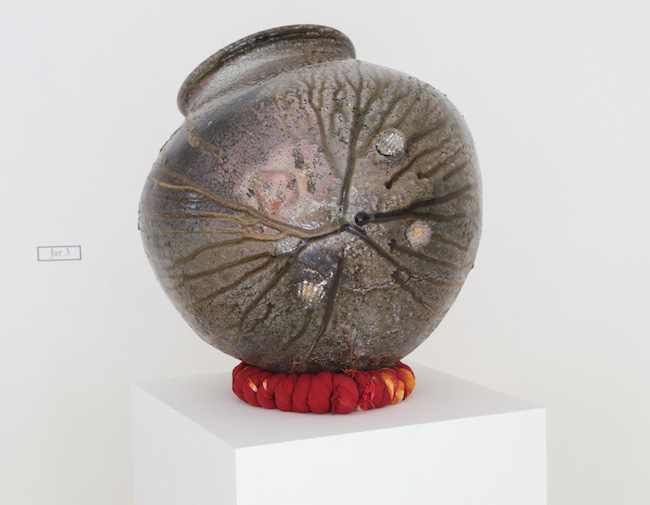Ray Meeker was originally born in California but he is best known for his work in India, where he is one of the most celebrated ceramic artists in the country.
Above image: Ray Meeker and T. Palanisamy, The Chinnagama. Installation view.
In 2014 Nature Morte, a gallery in New Delhi that showcases contemporary Indian art, held Meeker’s fourth solo exhibition there. 71 Running was a reference to the artist celebrating his 71st birthday with the intention of pushing forward with his artistic practice. The year before he was honored by his students with a show that paid tribute to his influence, but Meeker was not content to rest on his laurels. The following is Meeker’s statement regarding the personal, political and environmental themes present in 71 Running.
This is my fourth show with Nature Morte. This show, like the first three, presents a mix of sculpture and pottery. All of the works are wood-fired, from three different kilns. The pots draw on both Indian and Japanese traditions. The sculptures continue the environmental theme that I have worked with for many years, with the three previous exhibitions: Kurukshetra (2001), Subject to Change Without Notice (2004) and All the Kings Horses… (2008).
The Eye of the Needle series.
From The Bible, Matt. 19:24. “It is easier for a camel to pass through the eye of a needle than for a rich man to enter the kingdom of heaven.” Read “man” as “over-consumption” and “the kingdom of heaven” as “a healthy planet.” The title suggested itself when I scaled down Passage, the 21-foot-high gateway that I made for the Hyatt Hotel in Chennai, leaving a four inch slot as the way through. Monuments textured with fragments of text. Bolt heads, whip-sawed scrapes and scars, fissured layers of a tentative future. Man’s ingenuity at the crossroads to the tipping point.

Ray Meeker, Tea Bowls. Installation view.
Tea bowls.
Last year, Deborah and I traveled for three weeks in Japan on tour with American potter, Jeff Shapiro. Saw many tea bowls. I have long admired the tea bowl, but I rarely make them. A Japanese tea bowl in Indiais virtually non-functional. But coming out of a Zen Buddhist tradition that some trace back to Bodhi dharma of Kanchipuram, the tea bowl, I find, is an opportunity to close a migratory arc: India, China, Japan, and back home. Returning to Pondicherry, I decided to get familiar with that bowl. So 71 tea bowls, in fact all are not tea bowls. Some are tumblers for a stronger brew.

Ray Meeker, 71 Running. Installation view.
The Chinnagama.
Big round jars are ideal forms for ash deposit/runs. I work with T. Palanisamy, a traditional potter from Pudukotai district in Tamil Nadu. He makes the jars. I fire them in the Chinnagama which is a small Japanese style anagama, or cave kiln. It is fired with wood for 60 and 70 hours to 1300 degrees centigrade. Ashes are deposited on the jars which are then covered with embers that crust, melt and move on the surface of the jar, suggesting planetary landscapes and volcanic intensity.
Ray Meeker, artist.
Any thoughts about this post? Share yours in the comment box below.

Ray Meeker


Add your valued opinion to this post.